Do you have a question about the Arctic Cat 450 i and is the answer not in the manual?
Highlights the inherent dangers of operating an ATV and the need for precautions.
Explains the meaning of the Safety Alert Symbol, WARNING, CAUTION, and NOTE.
Warns about chemicals known to cause cancer and birth defects.
Emphasizes responsible riding, respecting laws, environment, and ATV.
Guidance on using genuine parts and availability of accessory catalogs.
Outlines the duration of warranty for recreational and commercial use.
Lists parts excluded and actions that will void the warranty.
Explains rights and obligations regarding the ATV's emission control system.
Details owner's duties for maintaining emission control system.
Lists engine management, fuel/air system, and miscellaneous emission parts.
Owner's role in maintaining the ATV for emission compliance.
Details dangers of operating ATVs, including terrain, speed, and obstacles.
Highlights risks of ATV use, including fatalities and injuries.
Lists essential safety measures for ATV operation.
Provides contact information for ATV safety courses and resources.
Explains the critical safety warnings on the ATV's hangtag.
Advises reading and understanding all safety labels on the ATV.
Operating without proper training increases accident risk.
Children under 16 may lack skills for safe ATV operation.
Carrying a passenger affects balance and control, increasing risk.
Paved surfaces affect ATV handling and control.
Operating without helmet, eye protection, and clothing increases injury risk.
Operating under influence impairs judgment and reaction time.
Riding at excessive speeds increases the risk of losing control.
Not inspecting or maintaining the ATV increases accident or damage risk.
Failure to use extra care on unfamiliar terrain can lead to loss of control.
Improperly crossing or turning on hills can cause loss of control or overturn.
Improper turning can lead to collision or rollover.
Climbing hills improperly can cause loss of control or overturn.
ATVs overturn more easily on steep hills than on level surfaces.
Stalling or rolling backward on hills can result in ATV overturning.
Overloading affects ATV handling, potentially leading to accidents.
Operating over obstacles improperly can cause loss of control or overturn.
Skidding or sliding can lead to loss of control and potential overturn.
Modifications can change ATV handling, leading to accidents.
Operating in reverse improperly can result in serious injury.
Operating on public roads increases collision risk and may be illegal.
Improper tires or pressure cause loss of control.
Operating in deep water can cause loss of traction and control.
Excessive throttle can cause wheelies, flip-overs, or loss of control.
Locked differential increases steering effort and reduces maneuverability.
Driving with brake lock engaged can cause loss of control or brakes.
Emphasizes prevention techniques like P.A.S.S. for safe riding.
Details essential protective clothing for ATV riding.
Importance of DOT, Snell, or ANSI compliant helmets.
Protects hands from weather, objects, and improves grip.
Recommends boots covering legs for impact protection and tread.
Lists required safety labels for helmets.
Stresses use of goggles for eye protection, not sunglasses.
Details the need for durable clothing for skin protection.
Introduces T-CLOC for pre-ride ATV condition checks.
Checking hand brake, rear foot brake, and lever lock for proper function.
Ensuring throttle has free, smooth range of motion.
Verifying headlights, taillight, brakelight, and indicators.
Ensuring full tank of gas and checking oil level and fluid leaks.
Checking suspension, shocks, fenders, and steering.
Inspecting air filter, battery, and tightening loose parts.
Lists minimum items for emergency preparedness on ATV rides.
Carrying essential tools to prevent inconveniences.
Water is crucial for preventing heat exhaustion and dehydration.
Carrying ID for emergency personnel to identify the rider.
Carrying a cell phone for urgent calls.
Using maps or GPS for navigation on unfamiliar trails.
Recommends items like flashlight, matches, flares, and first aid kit.
Explains how body weight affects ATV handling and stability.
Survey to assess personal risk-taking behavior.
Importance of considering weather conditions for safe riding.
Paying attention to terrain changes, even in familiar areas.
Hazards of night riding and precautions for visibility and speed.
ATVs are not designed for pavement; handling is difficult.
Tips for riding trails, visibility, and stopping.
Explains common symbols used for trail designation and restrictions.
Maintaining space from other riders and avoiding passengers.
Being aware of others on trails and roads, and keeping eyes open.
Guidance on not chasing animals and protecting young trees.
Emphasizes regular maintenance and consulting dealer for issues.
Details weight limits, distribution, and speed considerations for cargo.
Chart detailing maximum load capacities for various ATV components.
Emphasizes making safe choices despite the thrill of riding.
Strong warning against alcohol/drug use while riding.
Lists alcohol, drugs, and medications to avoid before/during riding.
Details how alcohol impairs judgment, perception, and coordination.
Advises against riding when physically exhausted.
Warns against speeding, stunts, and the increased risk of injury.
Stresses the importance of knowing and following local laws.
Discusses how group dynamics can lead to riskier behavior.
Explains the SIPDE acronym for safe and effective riding.
Ensuring untrained riders have proper instruction and supervision.
Acquainting experienced riders with specific ATV controls.
Recommends age-appropriate sized ATVs and supervision.
Step-by-step procedures for safely mounting and dismounting the ATV.
Safe steps for starting the ATV engine, including cold start.
How to shift between High, Low, and Reverse ranges.
Proper methods for braking, stopping, and avoiding brake loss.
Steps for safely parking the ATV, including on hills.
Procedure for dismounting after parking.
Learning to lean and shift weight for ATV control.
Techniques for maintaining control during turns.
Using body weight and leaning for wide turns.
Advanced skill of sharp turns after mastering wide turns.
Difficult turns for experienced riders.
Procedure for U-turns on hills when stalled.
Techniques for climbing hills to avoid rollovers.
Proper use of brakes when descending hills.
Advanced skill for riding on slopes; avoid if possible.
Emergency reaction similar to quick turns but without acceleration.
General guidelines for riding over two-track obstacles.
Covers reversing, skidding, parking on hills, water crossing, etc.
Ensuring controls are free and wearing appropriate clothing.
Procedures for safely stopping the vehicle and its engine.
Locating and recording vehicle identification numbers.
Understanding the ignition switch positions (OFF, ON, LIGHTS).
Identifies key controls on the ATV.
How to shift between High, Low, and Reverse ranges.
Selecting between two-wheel and four-wheel drive modes.
Operating the hand brake and its locking mechanism.
Using headlight switches and the engine stop switch.
How to use the starter button to start the engine.
Controlling engine RPM and adjusting throttle limiter.
How to apply the rear foot brake.
Information on the Electronic Power Steering system.
Explains the various indicators and displays on the LCD.
Troubleshooting codes for EPS system malfunctions.
Using buttons to navigate and set gauge displays.
How to read and reset odometer and trip meters.
Understanding gear selection and 4WD engagement indicators.
Indicators for drive mode and high beam status.
Monitors battery voltage and warns of low/high voltage.
Interpreting the engine temperature indicator and its warnings.
Understanding EFI error codes and malfunction indicators.
Shows the approximate amount of gasoline in the tank.
Indicates low oil pressure during self-test.
How to select between ODO, T1, and T2 displays.
Explains gear indicators including error signals.
How the speedometer and tachometer functions work.
Indicators for 4WD lock and drive select status.
Indicates when the high beam is active.
Monitors battery voltage and warns of low/high voltage.
Recommends replacing gas hoses every two years.
Procedure for checking engine oil level using the dipstick.
How to secure the seat properly before riding.
How to open and close the tailgate.
How to operate the cargo box latches.
How to open and close the side storage compartment.
Information on mounting a flag bracket.
Ensuring loads on racks are secure and don't interfere with controls.
Critical safety advice for towing trailers with an ATV.
Procedure for securing the ATV for transport.
Specifies recommended gasoline octane and lubricant types.
Safety precautions for filling the gas tank.
Importance of the break-in period for engine longevity.
Procedure to properly burnish new brake pads for effectiveness.
Stresses regular maintenance for optimal performance.
Advises taking ATV to dealer if unqualified for maintenance.
Procedure for checking and adding coolant.
Specific cleaning instructions for radiator core on Mud Pro models.
Checking and topping off brake fluid reservoir.
Ensuring the brake lever lock engages and disengages correctly.
Inspecting brake hoses for cracks or damage.
How to check brake pad thickness and when to replace.
Ensuring the rear foot brake is fully functional.
Checking brake fluid level and adding fluid if low.
Periodic inspection of protective boots.
Checking ball joint boots for cracks or tears.
Inspecting tie rod boots for damage and checking free-play.
Checking drive axle boots for tears or perforations.
Cleaning battery terminals with baking soda solution.
Using CTEK chargers for battery maintenance.
Steps for connecting charger and charging the battery.
Procedure for safely jump-starting an ATV with another vehicle.
Safety measures when working with batteries.
Correctly connecting jumper cables to avoid damage or injury.
Checking spark plug gap and proper tightening.
Adjusting throttle cable for proper free-play.
Procedure for removing, cleaning, and oiling the air filter element.
Checking the drain for debris and proper sealing.
Importance of tread depth and proper tire replacement.
Procedure for draining water from the V-belt cover.
Using proper tools and approved tires for replacement.
Repairing tire punctures and servicing wheels.
Periodically cleaning the spark arrester.
Using correct wattage bulbs for replacements.
Procedure for replacing the headlight bulb.
Procedure for replacing taillight and brakelight bulbs.
Steps for adjusting vertical and horizontal headlight aim.
Locating fuses and precautions for replacement.
Information on accessory output terminals.
Location of storage and provided tool kit.
Steps for cleaning and preparing ATV before storage.
Draining or stabilizing fuel for long-term storage.
Disconnecting and storing the battery properly.
Steps for preparing ATV after storage for use.
How to transfer the remaining warranty to a new owner.
Information on enrolling in ATV rider courses for skill enhancement.
Recording the key identification number for replacement.
Recording VIN and ESN for parts ordering and reference.
Highlights the inherent dangers of operating an ATV and the need for precautions.
Explains the meaning of the Safety Alert Symbol, WARNING, CAUTION, and NOTE.
Warns about chemicals known to cause cancer and birth defects.
Emphasizes responsible riding, respecting laws, environment, and ATV.
Guidance on using genuine parts and availability of accessory catalogs.
Outlines the duration of warranty for recreational and commercial use.
Lists parts excluded and actions that will void the warranty.
Explains rights and obligations regarding the ATV's emission control system.
Details owner's duties for maintaining emission control system.
Lists engine management, fuel/air system, and miscellaneous emission parts.
Owner's role in maintaining the ATV for emission compliance.
Details dangers of operating ATVs, including terrain, speed, and obstacles.
Highlights risks of ATV use, including fatalities and injuries.
Lists essential safety measures for ATV operation.
Provides contact information for ATV safety courses and resources.
Explains the critical safety warnings on the ATV's hangtag.
Advises reading and understanding all safety labels on the ATV.
Operating without proper training increases accident risk.
Children under 16 may lack skills for safe ATV operation.
Carrying a passenger affects balance and control, increasing risk.
Paved surfaces affect ATV handling and control.
Operating without helmet, eye protection, and clothing increases injury risk.
Operating under influence impairs judgment and reaction time.
Riding at excessive speeds increases the risk of losing control.
Not inspecting or maintaining the ATV increases accident or damage risk.
Failure to use extra care on unfamiliar terrain can lead to loss of control.
Improperly crossing or turning on hills can cause loss of control or overturn.
Improper turning can lead to collision or rollover.
Climbing hills improperly can cause loss of control or overturn.
ATVs overturn more easily on steep hills than on level surfaces.
Stalling or rolling backward on hills can result in ATV overturning.
Overloading affects ATV handling, potentially leading to accidents.
Operating over obstacles improperly can cause loss of control or overturn.
Skidding or sliding can lead to loss of control and potential overturn.
Modifications can change ATV handling, leading to accidents.
Operating in reverse improperly can result in serious injury.
Operating on public roads increases collision risk and may be illegal.
Improper tires or pressure cause loss of control.
Operating in deep water can cause loss of traction and control.
Excessive throttle can cause wheelies, flip-overs, or loss of control.
Locked differential increases steering effort and reduces maneuverability.
Driving with brake lock engaged can cause loss of control or brakes.
Emphasizes prevention techniques like P.A.S.S. for safe riding.
Details essential protective clothing for ATV riding.
Importance of DOT, Snell, or ANSI compliant helmets.
Protects hands from weather, objects, and improves grip.
Recommends boots covering legs for impact protection and tread.
Lists required safety labels for helmets.
Stresses use of goggles for eye protection, not sunglasses.
Details the need for durable clothing for skin protection.
Introduces T-CLOC for pre-ride ATV condition checks.
Checking hand brake, rear foot brake, and lever lock for proper function.
Ensuring throttle has free, smooth range of motion.
Verifying headlights, taillight, brakelight, and indicators.
Ensuring full tank of gas and checking oil level and fluid leaks.
Checking suspension, shocks, fenders, and steering.
Inspecting air filter, battery, and tightening loose parts.
Lists minimum items for emergency preparedness on ATV rides.
Carrying essential tools to prevent inconveniences.
Water is crucial for preventing heat exhaustion and dehydration.
Carrying ID for emergency personnel to identify the rider.
Carrying a cell phone for urgent calls.
Using maps or GPS for navigation on unfamiliar trails.
Recommends items like flashlight, matches, flares, and first aid kit.
Explains how body weight affects ATV handling and stability.
Survey to assess personal risk-taking behavior.
Importance of considering weather conditions for safe riding.
Paying attention to terrain changes, even in familiar areas.
Hazards of night riding and precautions for visibility and speed.
ATVs are not designed for pavement; handling is difficult.
Tips for riding trails, visibility, and stopping.
Explains common symbols used for trail designation and restrictions.
Maintaining space from other riders and avoiding passengers.
Being aware of others on trails and roads, and keeping eyes open.
Guidance on not chasing animals and protecting young trees.
Emphasizes regular maintenance and consulting dealer for issues.
Details weight limits, distribution, and speed considerations for cargo.
Chart detailing maximum load capacities for various ATV components.
Emphasizes making safe choices despite the thrill of riding.
Strong warning against alcohol/drug use while riding.
Lists alcohol, drugs, and medications to avoid before/during riding.
Details how alcohol impairs judgment, perception, and coordination.
Advises against riding when physically exhausted.
Warns against speeding, stunts, and the increased risk of injury.
Stresses the importance of knowing and following local laws.
Discusses how group dynamics can lead to riskier behavior.
Explains the SIPDE acronym for safe and effective riding.
Ensuring untrained riders have proper instruction and supervision.
Acquainting experienced riders with specific ATV controls.
Recommends age-appropriate sized ATVs and supervision.
Step-by-step procedures for safely mounting and dismounting the ATV.
Safe steps for starting the ATV engine, including cold start.
How to shift between High, Low, and Reverse ranges.
Proper methods for braking, stopping, and avoiding brake loss.
Steps for safely parking the ATV, including on hills.
Procedure for dismounting after parking.
Learning to lean and shift weight for ATV control.
Techniques for maintaining control during turns.
Using body weight and leaning for wide turns.
Advanced skill of sharp turns after mastering wide turns.
Difficult turns for experienced riders.
Procedure for U-turns on hills when stalled.
Techniques for climbing hills to avoid rollovers.
Proper use of brakes when descending hills.
Advanced skill for riding on slopes; avoid if possible.
Emergency reaction similar to quick turns but without acceleration.
General guidelines for riding over two-track obstacles.
Covers reversing, skidding, parking on hills, water crossing, etc.
Ensuring controls are free and wearing appropriate clothing.
Procedures for safely stopping the vehicle and its engine.
Locating and recording vehicle identification numbers.
Understanding the ignition switch positions (OFF, ON, LIGHTS).
Identifies key controls on the ATV.
How to shift between High, Low, and Reverse ranges.
Selecting between two-wheel and four-wheel drive modes.
Operating the hand brake and its locking mechanism.
Using headlight switches and the engine stop switch.
How to use the starter button to start the engine.
Controlling engine RPM and adjusting throttle limiter.
How to apply the rear foot brake.
Information on the Electronic Power Steering system.
Explains the various indicators and displays on the LCD.
Troubleshooting codes for EPS system malfunctions.
Using buttons to navigate and set gauge displays.
How to read and reset odometer and trip meters.
Understanding gear selection and 4WD engagement indicators.
Indicators for drive mode and high beam status.
Monitors battery voltage and warns of low/high voltage.
Interpreting the engine temperature indicator and its warnings.
Understanding EFI error codes and malfunction indicators.
Shows the approximate amount of gasoline in the tank.
Indicates low oil pressure during self-test.
How to select between ODO, T1, and T2 displays.
Explains gear indicators including error signals.
How the speedometer and tachometer functions work.
Indicators for 4WD lock and drive select status.
Indicates when the high beam is active.
Monitors battery voltage and warns of low/high voltage.
Recommends replacing gas hoses every two years.
Procedure for checking engine oil level using the dipstick.
How to secure the seat properly before riding.
How to open and close the tailgate.
How to operate the cargo box latches.
How to open and close the side storage compartment.
Information on mounting a flag bracket.
Ensuring loads on racks are secure and don't interfere with controls.
Critical safety advice for towing trailers with an ATV.
Procedure for securing the ATV for transport.
Specifies recommended gasoline octane and lubricant types.
Safety precautions for filling the gas tank.
Importance of the break-in period for engine longevity.
Procedure to properly burnish new brake pads for effectiveness.
Stresses regular maintenance for optimal performance.
Advises taking ATV to dealer if unqualified for maintenance.
Procedure for checking and adding coolant.
Specific cleaning instructions for radiator core on Mud Pro models.
Checking and topping off brake fluid reservoir.
Ensuring the brake lever lock engages and disengages correctly.
Inspecting brake hoses for cracks or damage.
How to check brake pad thickness and when to replace.
Ensuring the rear foot brake is fully functional.
Checking brake fluid level and adding fluid if low.
Periodic inspection of protective boots.
Checking ball joint boots for cracks or tears.
Inspecting tie rod boots for damage and checking free-play.
Checking drive axle boots for tears or perforations.
Cleaning battery terminals with baking soda solution.
Using CTEK chargers for battery maintenance.
Steps for connecting charger and charging the battery.
Procedure for safely jump-starting an ATV with another vehicle.
Safety measures when working with batteries.
Correctly connecting jumper cables to avoid damage or injury.
Checking spark plug gap and proper tightening.
Adjusting throttle cable for proper free-play.
Procedure for removing, cleaning, and oiling the air filter element.
Checking the drain for debris and proper sealing.
Importance of tread depth and proper tire replacement.
Procedure for draining water from the V-belt cover.
Using proper tools and approved tires for replacement.
Repairing tire punctures and servicing wheels.
Periodically cleaning the spark arrester.
Using correct wattage bulbs for replacements.
Procedure for replacing the headlight bulb.
Procedure for replacing taillight and brakelight bulbs.
Steps for adjusting vertical and horizontal headlight aim.
Locating fuses and precautions for replacement.
Information on accessory output terminals.
Location of storage and provided tool kit.
Steps for cleaning and preparing ATV before storage.
Draining or stabilizing fuel for long-term storage.
Disconnecting and storing the battery properly.
Steps for preparing ATV after storage for use.
How to transfer the remaining warranty to a new owner.
Information on enrolling in ATV rider courses for skill enhancement.
Recording the key identification number for replacement.
Recording VIN and ESN for parts ordering and reference.
| Brand | Arctic Cat |
|---|---|
| Model | 450 i |
| Category | Offroad Vehicle |
| Language | English |
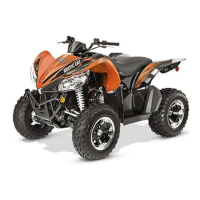
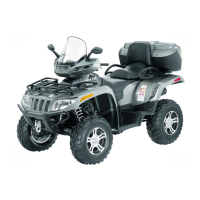

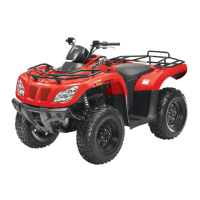
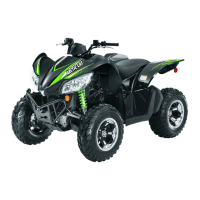

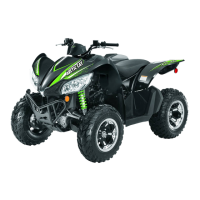
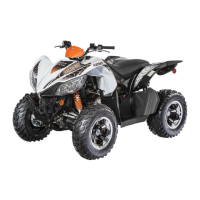




